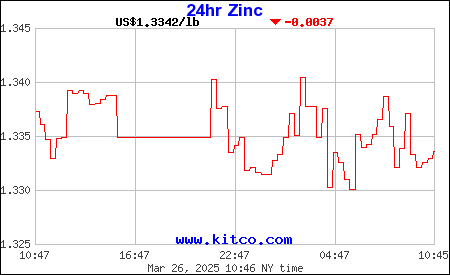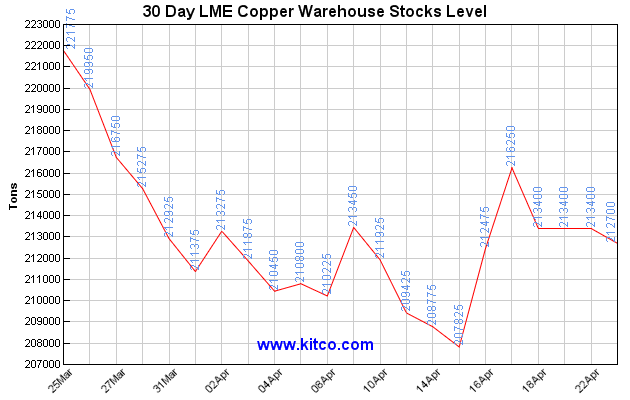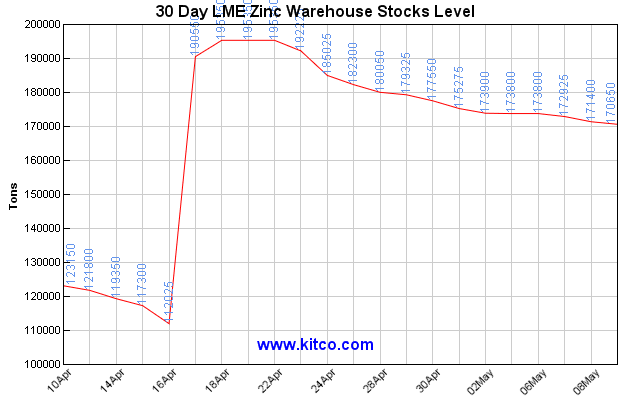

Post says Breakwater takes zinc's plunge on the chin
2007-11-21 09:07 ET - In the News
The Financial Post reports in its Wednesday edition that investors have been frantically selling shares of Breakwater Resources in the last five weeks, slicing the share price by nearly half.
The Post's Peter Koven, writing in Trading Desk, says Canaccord Adams analyst Orest Wowkodaw said that part of the reason for the sell-off is the company's operational difficulties, including a water discharge problem at its Mochito mine and a road closure at its Myra Falls mine.
The bigger issue, says Mr. Wowkadaw, is the zinc market, which is looking like it could be very oversupplied "and Breakwater is just feeling the brunt of that." Spot zinc prices are down about 20 per cent in the last 30 days. Others have speculated that Breakwater could also be feeling the affects of the potential sale of DundeeWealth. Dundee Corp., the parent, holds a 24-per-cent share of Breakwater, and there is some talk the controlling Goodman family could sell that interest. Mr. Wowkodaw does not believe that is an issue. "Now that Scotiabank has come in (buying a minority share of Dundee), I see the risk of a distressed sale as relatively low. So I don't think the Goodmans are sellers at anything close to this current price."
Insiders Activity


Click Pics Bigger



Copper, zinc futures plummet in Shanghai
Updated: 2007-11-21 10:41
On the heels of the crash in international markets, Shanghai copper and zinc futures yesterday dropped to the daily allowable limits, reaching the lowest levels since early this year.
The most actively traded copper futures contracts for January delivery on Shanghai Futures Exchange (SHFE) slumped 4.01 percent to 55,780 yuan per ton, the lowest price level since February. The most actively traded zinc futures contracts for delivery in January on SHFE plummeted 6.01 percent to close at 18,205 yuan per ton, the lowest since zinc futures started trading in SHFE this April.
Last Friday, copper and zinc futures on the London Metals Exchange (LME) saw the biggest single-day drop yet. Copper futures contracts tumbled 5.11 percent to close at $6,690 per ton, while zinc futures contracts plunged 8.79 percent to close at $2,310 per ton.
Analysts said a combination of factors, including rising crude oil prices worldwide, shrinking US property sales figures and rocketing farm product prices, could signal the beginning of a US-led global economic down-cycle.
"Investors are beginning to take a more cautious attitude toward the market trend, as the US property market is showing no sign of recovery after being hit by the subprime mortgage crisis," said Zhou Jie, a non-ferrous metals analyst at China International (Shanghai) Futures Co. "The latest figures show that the even lower confidence in US home builders intensifies investors' concerns about the US property market," Zhou added.
According to the US National Association of Home Builders (NAHB), the November housing market index held even with October's 19 reading, its lowest point since the series began in January of 1985.
"Builder confidence in the market for new, single-family homes remained unchanged in November due to continuing mortgage market problems," said the NAHB report released on Monday.
Industrial experts and analysts said the continuous inventory rises of non-ferrous metals has also contributed to the price slump over the past several weeks.
The latest figures show that the LME copper inventory last week reached 180,000 tons, up 50 percent form the previous month, close to the record high of 200,000 tons recorded early this year.
The copper inventory in SHFE also rose 18 percent from September to 57,000 tons last Friday.
Copper, Zinc Fall Limit on Stockpile Gains, U.S. Demand ConcernBy Li Xiaowei
Nov. 20 (Bloomberg) -- Copper futures in Shanghai fell the maximum daily limit to the lowest in more than eight months as an increase in global inventories of the metal signaled weaker demand. Zinc also dropped the exchange-imposed limit.
Copper stockpiles monitored by the London Metal Exchange rose yesterday to the highest since April 2, with most increases in warehouses located in the U.S., the world's second-biggest user of the metal after China. U.S. demand has been reduced by a housing slump and speculation economic growth will slow.
``If the Fed makes no further rate cuts, the U.S. economy is bound to be hurt, reducing demand for metals,'' Cai Jinrong, an analyst at metals trader Wanxiang Resources Co., said by phone from Shanghai today.
Copper for January delivery fell 4 percent from the previous settlement price to close at 55,780 yuan ($7,513) a metric ton, the lowest close since March 5. Shanghai zinc for January delivery fell 6 percent from the previous settlement to 18,205 yuan a ton, the lowest since the contract was introduced in March.
The metal for immediate delivery in Changjiang, Shanghai's biggest cash market, lost as much as 4.3 percent to 56,450 yuan a ton today.
London Metal Exchange copper for delivery in three months fell 1.7 percent $6,680 a ton at 3:36 p.m. in Shanghai, after falling as much as 5.3 percent yesterday. LME zinc for delivery in three months lost 2 percent to $2,307 a ton.
Stockpiles of copper gained 1,275 tons, or 0.7 percent, to 180,925 tons yesterday, the 10th straight daily gain, according to exchange data. Supplies have increased 8.4 percent this month.
Recession Forecasts
The number of economists forecasting the U.S. will slip into recession almost doubled over the last two months, a survey by the National Association for Business Economics showed. Housing starts in the U.S. probably fell to a 14-year low in October, signaling a real-estate slump will continue to weigh on growth, economists said before a report today.
Zinc fell to a 20-month low in London yesterday as shipments from China, the world's largest producer of the metal, may have accelerated on speculation the government will end a 5 percent tax rebate on exports next year.
Holders of stockpiled zinc may have sought ``to liquidate'' before the change, Michael Jansen, an analyst at JPMorgan Securities Ltd., said in a report yesterday. Exports from China jumped 21 percent in the first 10 months of this year, helping send zinc prices down 45 percent.
Exports were 8,964 tons in October compared with 12,325 tons in the previous month and the record high of 81,905 tons in December 2006, according to customs data.
Zinc Exports
``We expect zinc exports to rebound in the remainder of this year from the October low as an oversupply in the domestic market pushes down local prices,'' Xuan Long, an analyst at Huawen Futures Brokerage Co., said by phone from Shanghai today,
``Speculation about the cancellation of tax benefits may be another incentive to export more,'' Xuan said.
Shanghai aluminum for January delivery lost 0.9 percent to 17,860 yuan a ton, and LME aluminum was 0.4 percent higher at $2,520 a ton at 3:45 p.m.
Among other LME-traded metals, lead was 0.5 percent down at $3,035 a ton, nickel added 0.2 percent to $30,250 a ton, and tin was 0.2 percent higher at $16,800 a ton.












